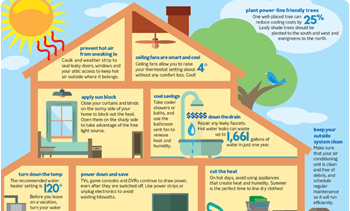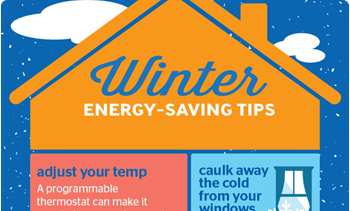Three Ways to Insulate Your Home
More Videos From Our YouTube Channel
Weatherstrip Your HomeHelpful Tips for Sealing Ducts
Seal Your Home to Make it More Energy Efficient
LED and CFL bulbs
Lighting Color Comparison
-
Thermostat
In the summer, set the thermostat between 76 and 78 degrees when you are home. In the winter, set your thermostat at 68 degrees and lower it two or three degrees when you’re going to be gone for several hours.
Use a ceiling fan to regulate the “feels like” temperature in your home instead of adjusting your thermostat. Just remember to turn it off when you leave the room. A ceiling fan should rotate counterclockwise in the summer. Use the lowest speed and reverse the direction the blades turn to clockwise in the winter.
One of the easiest ways to save on your heating bill is to turn the thermostat down and throw an extra blanket on the bed at night, or bundle up with a cozy sweater and warm socks. A programmable thermostat can make it easy to keep your house at the recommended seasonal temperature when you’re at home, while automatically adjusting the thermostat to turn up or down a few degrees when you leave or go to sleep.Regardless of the season, the smaller the difference between the indoor and outdoor temperatures, the lower your heating and cooling costs will be.
-
Windows & Doors
In the summer, close curtains and blinds on the sunny side of your home to block out heat. Open them on the shady side for a free light source. In the winter, keep blinds open during the day to let direct sunlight generate warmth. Close them at night to hold in the heat.
Check each window to ensure there is no missing glass, rotting wood or broken parts. Use caulk or weather stripping to seal leaky windows and exterior doors. If you can see light around your door threshold or feel cold air seeping through your windows, you’re losing energy and reducing the comfort level of your home.
If your windows are in fairly good condition, attaching low-e storm windows can boost energy efficiency at about a quarter of the cost of a total replacement. Storm windows reduce air infiltration, whether they are coated or not. However, low-e coating, a nearly invisible layer on the glass, can improve overall energy savings 10-15 percent more than standard storm windows.
Typically, storm windows should be custom ordered to fit your existing windows. They are available at both independent window dealers and big-box retailers. Modern storm windows can be left in place year-round, and insect screens means you can open your windows without letting in unwanted pests.
If storm windows aren’t an option, try applying heat shrink film, which looks like a thicker version of plastic wrap. Sheets of the film can be cut to size and attached to the inside of the window frame with double-sided tape. Use a hair dryer to shrink the film to provide a better seal around the window.
Bonus cold weather tips: keep your garage door closed as much as possible to help keep cold air out of your house. When you shower, consider leaving the bathroom door open so steam spreads to other rooms but don’t use the ventilation fan. It will remove the warm air you’re hoping to keep in the house.
-
HVACSince the largest percentage of your energy bill is your heating and cooling system, maintaining it is one of the best things you can do to lower your bill. Keep your outside unit free of debris and grass clippings. Get the HVAC system serviced every year including a check on refrigerant levels, the compressor, hoses, ductwork and thermostat. Make sure to clean or replace air filters regularly.
Do not turn off your HVAC system during winter. Instead, lower the thermostat several degrees to save energy when you aren’t at home. Turning it off completely can result in higher energy usage upon your return and puts your pipes at risk of freezing.
Consider the savings potential of replacing your old HVAC with an energy-efficient heat pump using this Heat Pump Calculator. Estimate the cost of supplemental heat during cold winter months with our Space Heater Calculator.
Research shows that summer air temperatures in tree-shaded neighborhoods can be three to six degrees cooler than treeless areas. Carefully positioned trees around your home can reduce your cooling costs by up to 25 percent. In addition, shading your outdoor unit can help lower the energy used to cool your home; just be sure not to block airflow. -
AppliancesSet your refrigerator at 40 degrees and let food cool before putting it in the refrigerator. Hot foods will raise the temperature in the fridge and make it work harder.
Every time you open the door, the oven’s temperature drops about 25-30 degrees and more energy is used to reheat it to the right temperature. Use the oven light instead.
Sizing pots to the right stovetop burner can make a big difference. A six-inch pot on an eight-inch burner wastes over 40 percent of the burner’s heat. Also, covering pots and pans reduces heat loss and allows food to cook more efficiently.
When entertaining, cook as many dishes as possible in your microwave, which uses about 50 percent less energy than a conventional oven.
Wash full loads of clothes and use cold water when possible. Unless you’re dealing with oily stains, the warm or cold water setting on your machine will generally do a good job of cleaning your clothes. Switching from hot to warm can cut your load’s energy use in half. If you have a front-loading washer or high-efficiency top-loader, use detergent labeled for high-efficiency machines. And, don’t forget to air dry clothing outside or on a drying rack when temperatures are favorable.
Run the dishwasher when it’s completely full.
In the summer, avoid using appliances that create heat and humidity, such as the oven, dishwasher and clothes dryer during the hottest part of the day. Summer is a perfect time to grill out and line dry clothes.
Shopping for a new appliance, thermostat or television? We make it easy to compare and find the best prices on the most efficient options. Explore top-rated energy-efficient appliances and electronics at the EnergyRight Marketplace. Always buy Energy Star certified products to save money on your energy bill.
Eliminate phantom load by using a power strip for your entertainment center, computer and other electronics to completely disconnect from the power source. Older set-top cable boxes and DVRs are some of the most frightening energy vampires since they constantly drain 25-45 watts of energy when not in use. Just remember that if you’re planning to record a show, your cable box must be on.
Before you leave for the day, make a habit of unplugging all unnecessary appliances including your coffee maker, microwave, toaster oven and other unused appliances. Hair dryers, curling irons and electric shavers left plugged into the wall while not in use can still drain electricity.
Once your cell phone or tablet is powered up, unplug the charger to avoid wasting energy. Also, be sure to power down your video game console when it’s “game over.”
Find out how much energy the appliances in your home use with the Appliance Calculator. Use the TV Calculator to compare energy costs based on the type of television you own. -
Water Heater
After your HVAC system, the water heater is typically the second largest component of your energy bill.
Set the water heater thermostat to 120 degrees and take cooler showers. Use cold water to wash clothes.
If you have an older tank located in an unheated area, wrapping it with a water heater insulation blanket is a cheap and easy way to reduce water-heating costs.
Reduce your hot water use by taking shorter showers instead of baths and using cold water for full loads of laundry.
Turn off the breaker for your water heater if you are going to be gone for longer than three days.
-
Fireplace
There’s nothing better than cozying up to a warm fire during the winter months, but make sure to keep an eye on your chimney. It can act like an open window when the fireplace is not in use. Close the damper after the fire is completely out so you don’t lose your heated air. If you never use your fireplace, consider plugging and sealing the chimney flue.
-
Lights & Holiday LightingTurn off lights when you leave the room, and use a timer on them strategically so your house will be well lit when you get home. This will ensure that selected lights are only on when needed and avoids excess energy use, while also keeping your home safe.
Light Emitting Diodes lightbulbs, also known as LEDs, use 75 percent less energy than incandescent lighting, they last about 40 times longer than incandescent bulbs and three times longer than fluorescents. They produce very little heat and are extremely durable.
Keep light fixtures and bulbs clean. Dust absorbs 50 percent of light.
Strands of LED lights can save more than 75 percent compared to incandescent lights. Plus, they put off less heat, helping to reduce the risk of fire and they last up to 10 years longer.
Try to cut down on the number of strands you use. Rather than adding more lights to your tree, try enhancing the existing lighting with tinsel, mirrored ornaments and other reflective items.

